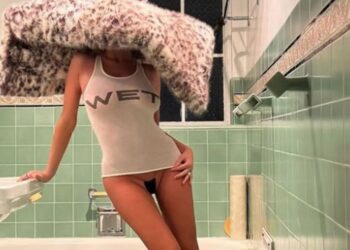In Korea, padding (패딩) or padded jackets, often referred to as the “national” coat, are a winter wardrobe staple. Their popularity among Koreans stems from several factors. These jackets are designed to be unisex, appealing to men and women in various styles, including chic padded coats and practical short ones. Padded jackets are renowned for their warmth and ease of wear, often negating the need for multiple layers – a simple T-shirt underneath suffices. They have also become a fashion statement among the youth, celebrated for their lightweight materials and stylish designs. For tourists, particularly those encountering their first Korean winter, it’s advisable to consider seven key factors before investing in a padded jacket.
A Guide to Korea’s Padded Jackets – Important Keys
1. The Padded Jacket Parts
The padded jacket consists of three main components: the outer layer (겉감), lining (안감), and filling (충전재).
The outer layer (겉감) is a covering for the filling material and is commonly made of a special waterproof and windproof fabric. It covers the filling and is typically made from a special, waterproof, and windproof fabric.
Meanwhile, the lining (안감) is the part that touches the body, so it will be made from a material that is soft and non-irritating.
The filling (충전재) acts like the cotton in a blanket and provides insulation. Common materials for padding include:
- Cotton
- Wellon (special cotton fiber with added heat-retaining function)
- Duck down feathers (덕다운)
- Goose down feathers (구스다운)
- Wild goose down feathers (와일드 구스다운)
Furthermore, advanced padding designs may also incorporate materials that reduce static electricity, reflect body heat, or possess self-heating capabilities.
2. The Materials
Padded jackets are made from either natural or man-made materials. Natural materials typically consist of feathers from birds like ducks and geese. On the other hand, man-made materials include cotton polyester, synthlate, Wellon, and similar components. Artificial materials are more affordable than natural materials, which are harder to obtain.
Wellon cotton has recently emerged as a popular choice in padding manufacturing. This specially processed fine fiber offers more warmth and is lighter than traditional cheap cotton. It also eliminates concerns about avian feather allergies. Due to its affordability, Wellon cotton is particularly favored among Korean consumers, including students, who often prefer jackets from this material over those filled with goose or duck down.
3. Duck Down or Goose Down
Down feather padding is derived from the feathers on a bird’s chest, known for their lightness, porous structure, and excellent heat retention, surpassing the insulating ability of wing feathers. Duck-down padding, while less efficient in heat retention than goose-down, is more affordable.
Goose-down padding, on the other hand, can trap a larger volume of air, enhancing its warmth-retaining capabilities. The down of geese from cold, dry climates is particularly effective for insulation. The Korean market has also seen the introduction of wild goose-down padding. Unlike the typical white goose down, wild goose down feathers are usually gray, offering a unique variation in padding materials.
4. Feather-to-cotton Ratio
Present-day padded jackets in the market typically incorporate a mix of feathers and cotton fibers. Given their soft nature, using only feathers can lead to difficulty in inflating the padding and insufficient space for trapping air, which is crucial for insulation.
To counter this, manufacturers introduce cotton fibers in conjunction with the feathers. This addition helps create necessary air layers within the padding, enhancing its insulating properties. The ideal proportion of these two components – cotton fibers to feathers – is often maintained at 9:1 or 8:2, striking a balance that optimizes warmth and structure.
5. How Manny Feathers?
When selecting a padded jacket, the quantity of feathers used is a crucial factor, directly impacting the price. Jackets with more than 300g of feathers are classified as heavy padding, making them ideal for extremely cold environments, where temperatures can drop to around -25 degrees Celsius.
In Korea, where the lowest temperatures on the coldest days are not as severe, padding containing between 220 to 250 grams of feathers is typically sufficient. This weight range offers appropriate insulation for the Korean climate without being overly heavy or excessively warm.
6. Fill Power
Its thickness or weight doesn’t solely determine the warmth of a padded jacket. In Korea, advancements in garment technology have led to various padding options that are lightweight, warm, and convenient.
“Fill power” is a key term in this context, referring to the capacity of the down or cotton to regain its volume after being compressed. A higher fill power indicates that a given weight of down can trap more air, thereby enhancing its insulating properties. Padding with a fill power ranging from 650 to 700 for the Korean winter is generally adequate. This range offers sufficient insulation for typical winter conditions in Korea, balancing warmth with lightness and comfort.
7. How to Wash Padded Jackets
There’s a common misconception that padded jackets, especially those made with expensive feathers, require dry cleaning. However, considering that birds like ducks and geese, whose feathers are often used in these jackets, swim in water, it’s clear that water doesn’t inherently damage these feathers.
Therefore, washing a padded jacket with water, with hand washing being the recommended method, is generally considered safe and does not negatively affect the quality of the jacket. This approach can be a practical and effective way to maintain the cleanliness of the padding without compromising its insulation properties.
Styling Your Padded Jackets Like Korean Stars
Padded jackets goes well with various styles, from casual looks to stylish looks. If you want to be a little more stylish, choose short padding; if warmth is essential, choose long padding. Long padding that is voluminous, shiny, or colorful can create a dramatic effect. During concerts and activities held in the winter, padding is an item that provides warmth while maintaining style. If you want to wear padding stylishly beyond just keeping you warm, check out the padding styling of Korean stars.
Kim Na-young
Song Kang
LE SSERAFIM Kazuha
Jo Yuri
IVE Jang Wonyoung
Super Junior Lee Donghae
More winter fashion inspirations:
- 10 Chic Long Skirt Styles for Winter That Are Both Cozy and Trendy
- Elevate Your Look with Knee-High Socks à la K-pop Fashion Icons
- Embracing the Winter with Style: Kpop Idols Rocking Black Long Boots with Impressive Outfit
- Mastering the Art of Wearing Red and How to Utilize the Color Like Kpop Idols
- Balaclava Trend Takes Over: See How Kpop Idols Demonstrate Their Winter Fashion Styles!









